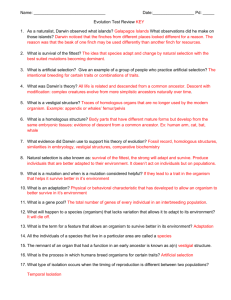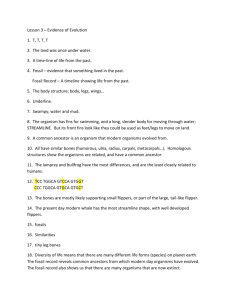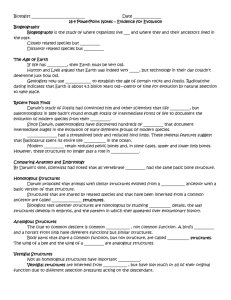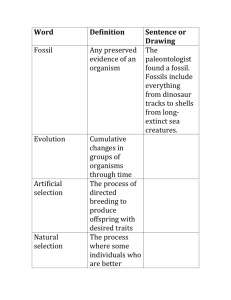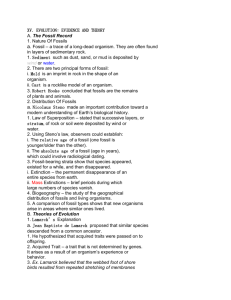Chapter 15 Evolution: Evidence and Theory
advertisement
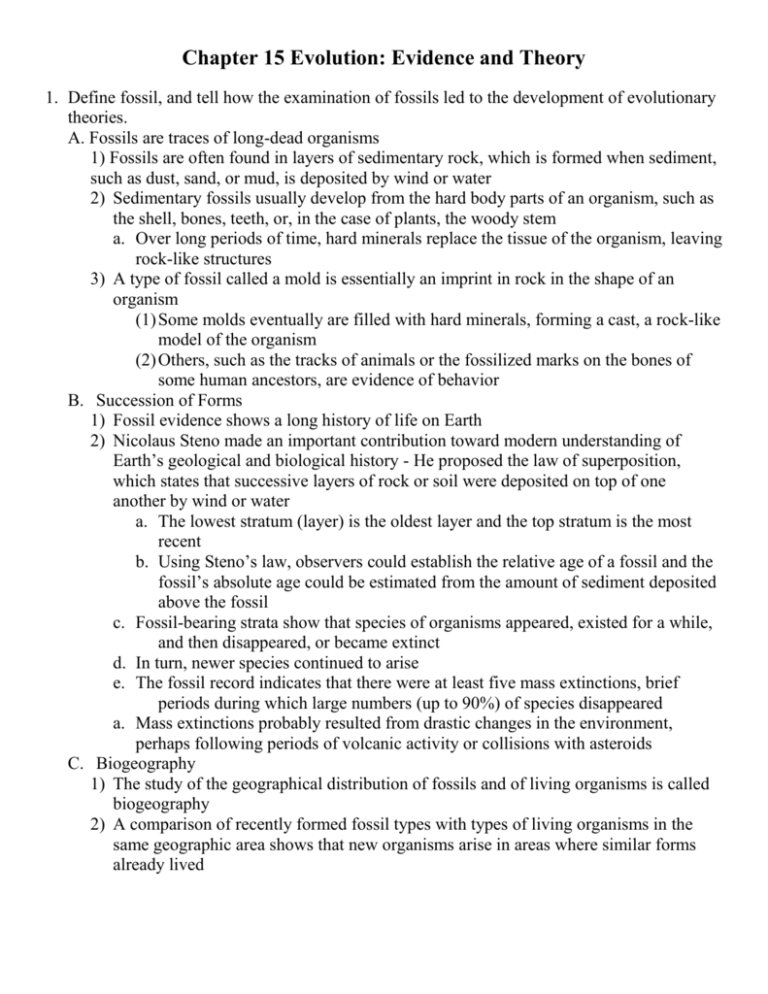
Chapter 15 Evolution: Evidence and Theory 1. Define fossil, and tell how the examination of fossils led to the development of evolutionary theories. A. Fossils are traces of long-dead organisms 1) Fossils are often found in layers of sedimentary rock, which is formed when sediment, such as dust, sand, or mud, is deposited by wind or water 2) Sedimentary fossils usually develop from the hard body parts of an organism, such as the shell, bones, teeth, or, in the case of plants, the woody stem a. Over long periods of time, hard minerals replace the tissue of the organism, leaving rock-like structures 3) A type of fossil called a mold is essentially an imprint in rock in the shape of an organism (1) Some molds eventually are filled with hard minerals, forming a cast, a rock-like model of the organism (2) Others, such as the tracks of animals or the fossilized marks on the bones of some human ancestors, are evidence of behavior B. Succession of Forms 1) Fossil evidence shows a long history of life on Earth 2) Nicolaus Steno made an important contribution toward modern understanding of Earth’s geological and biological history - He proposed the law of superposition, which states that successive layers of rock or soil were deposited on top of one another by wind or water a. The lowest stratum (layer) is the oldest layer and the top stratum is the most recent b. Using Steno’s law, observers could establish the relative age of a fossil and the fossil’s absolute age could be estimated from the amount of sediment deposited above the fossil c. Fossil-bearing strata show that species of organisms appeared, existed for a while, and then disappeared, or became extinct d. In turn, newer species continued to arise e. The fossil record indicates that there were at least five mass extinctions, brief periods during which large numbers (up to 90%) of species disappeared a. Mass extinctions probably resulted from drastic changes in the environment, perhaps following periods of volcanic activity or collisions with asteroids C. Biogeography 1) The study of the geographical distribution of fossils and of living organisms is called biogeography 2) A comparison of recently formed fossil types with types of living organisms in the same geographic area shows that new organisms arise in areas where similar forms already lived 2. Define evolution. A. The word evolution refers to an orderly succession of changes B. It is the change in allele frequency in a population over time 3. Explain Lamarck’s theory of evolution, and describe how it was flawed. A. He proposed that similar species descended from common ancestor, thus living species were descended from similar extinct species evident in the fossil record. 1) He cataloged an extensive collection of invertebrates and related them to living animals based on similar appearances B. To explain how species changed, he hypothesized that acquired traits were passed onto offspring 1) An acquired trait is one that is not determined by genes a. It comes about as a result of behavior over a lifetime b. If it’s favorable, it will be preserved and then passed on to the organism’s offspring 4. Explain Darwin’s two major theories. A. In the mid-1800s, Charles Darwin and Alfred Wallace independently proposed the hypothesis that species were modified by natural selection 1) Natural Selection – organisms best suited to their environment reproduce more successfully than other organisms a. Thus, over time, organisms with favorable traits increase within a population– interbreeding single-species group B. In 1831, Darwin sailed on the ship H.M.S. Beagle 1) The Beagle was chartered for a five-year mapping and collecting expedition to South America and the South Pacific 2) Darwin assumed the post of ship naturalist, which required that he collect specimens and keep careful records of his observations a. On the voyage, Darwin read Charles Lyell’s book “Principles of Geology”, which explained Jean Baptiste Lamarck’s theory of evolution - Lyell agreed with Lamarck but said that this change occurred over time and very slowly 1. This theory said that evolution occurs through use and disuse of physical features by individual members of species 2. These acquired “traits” would then be passed on from parent to offspring a. The book also talked about the principles of uniformitarianism, which holds that the geological structure of Earth resulted from the cycles of observable processes and that these same processes operate continuously through time – proposed by Geologist James Hutton b. In 1859, he finally published a book called “The Origin of Species by Means of Natural Selection” C. Darwin’s first theory—descent with modification—states that the newer forms appearing in the fossil record are actually the modified descendants of older species 1) Darwin inferred that all species had descended from one or a few original types of life a. He then reasoned that all living things probably had likewise descended from one, or perhaps a few, remote common ancestors that lived a very long time ago (1) Bear in mind that the terms recent ancestor and remote ancestor are used in the context of geologic history—the span of time—rather than in the context of a single human lifetime 2) Darwin’s first theory accounted for the fact that similar organisms arise in the same geographic location a. Darwin’s theory of evolution explained the observation that organisms give rise to others similar to themselves D. Darwin’s second theory—modification by natural selection—states how evolution occurs 1) He got the idea from English economist Thomas Malthus a. He stated that there are things in place to keep the populations under control Examples being disease, war, and famine - These things keep the human population under control - If they didn’t exist, eventually humans would cover the earth and we’d run out of food sources 2) Darwin proposed that the environment may affect individual organisms in a population in different ways because individuals of a species are not identical a. Some organisms have traits that make them better able to cope with their environment b. Organisms that have a greater number of these favorable traits tend to leave more offspring than organisms with fewer beneficial traits c. Darwin called the different degrees of successful reproduction among organisms in a population natural selection 1) If a trait both increases the reproductive success of an organism and is inherited, then that trait will tend to be passed on to many offspring a) A population of organisms adapt to their environment as their proportion of genes for favorable traits increases b) The resulting change in the genetic makeup of a population is evolution c) In an evolving population, a single organism’s genetic contribution to the next generation is termed fitness (1) Thus, an individual with high fitness is well adapted to its environment and reproduces more successfully than an individual with low fitness (2) The environment “selects” the traits that will increase in a population (3) The kinds of traits that are favorable depend on the demands of the environment (4) An organism with a favorable trait is said to have an adaptive advantage 2) Traits that are favorable for some organisms in some environments are not necessarily favorable for all organisms or all environments 5. Describe the difference between homologous, analogous, and vestigial structures. A. Homologous 1) Similar features that originated in a shared ancestor are described as homologous features 2) Homologous features can result from modifications that change an original feature to two extremely different types, such as a wing and an arm a. For example: the forelimbs of all vertebrates are made from the same basic bones, even though they don’t all share the same function 2) The presence of homologous features in different species indicates that the species shared a fairly recent common ancestor B. Analogous features serve identical functions, and they look somewhat alike 1) They have very different embryological development, however, and may be very different in internal anatomy 2) For example: a hummingbird and a humming moth (or a dolphin and a shark) 3) There is no anatomical or embryological similarity, however, between their wings 4) Birds and insects differ greatly in anatomy and in embryological development C. Vestigial Structures 1) Vestigial structures: a structure which is reduced in size and function; considered to be evidence of an organism’s evolutionary past 2) Many organisms have features that seem to serve no useful function a. For example, humans have a tailbone at the end of the spine that is of no apparent use b. The human appendix, a small, fingerlike projection from the intestine, also has no known function c. Some snakes have tiny pelvic bones and limb bones d. Whales also have pelvic bones, along with a four-chambered stomach like that of a cow 3) These apparently useless features are said to be vestigial a. Vestigial features were useful to an ancestor, but they are not useful to the modern organism that has them b. The vestigial tailbone in humans is homologous to the functional tails of other vertebrate species c. A vestigial feature in a modern organism is evidence that the structure was functional in some ancestor of the modern organism 1) Moreover, an organism with a vestigial feature probably shares common ancestry with an organism that has a functional version of the same feature 6. Tell how similarities in macromolecules and embryos of different species suggest a relationship between them. A. Evolution in Process – Evidence of Evolution 1. If a species has changed over time, then the genes that determine their characteristics should also have changed (usually due to mutations) B. Similarities in Macromolecules 1. The amino acid sequence of proteins is genetically determined by an organisms DNA 2. If evolution has taken place, then species that descended from a common ancestor in the distant past should have more amino acid sequence differences between their proteins than do species that share a common ancestor a. For example: humans and gorillas have few amino acid sequence differences (because we “share” a recent common ancestor), but humans and frogs have many amino acid sequence differences because the common ancestor we share is a much more distant relative C. Looking at Nucleic Acids 1. Nucleotide changes (such as substitution) cause changes in the amino acid sequence of a protein 2. Scientists can directly estimate the number of nucleotide changes that have taken place in a gene since 2 species diverged from a common ancestor - They do this by comparing the exact nucleotide sequence of each species a. They construct a phylogenetic tree, which shows how organisms are related through evolution D. Anatomy and Development Suggest Common Ancestry 1. Comparison of the anatomy (structure) of different types of organisms often reveal basic similarities in body structures, even though their functions may be very different a. Vestigial, homologous, analogous structures 2. The evolutionary history of organisms can also be seen in the development of embryos 7. Explain the difference between coevolution, and divergent and convergent evolution. A. Patterns of Evolution 1. Coevolution: the change of 2 or more species in close association with one another a. Example: predator/prey relationships 2. Convergent evolution: organisms that appear to be very similar are not closely related at all a. Example: a shark and porpoise 3. Divergent Evolution: 2 or more related populations or species become more and more dissimilar a. Can be because of adaptive radiation, which means that many related organisms evolve from a single ancestral species, but change in response to their environment b. Can be because of artificial selection, which means that divergent evolution is sped up artificially Example: domestic dogs are all the same species but we breed dogs for certain traits Pit bulls, Rottweilers, Dalmatians, etc. 4. Gradualism: the model that evolution occurs gradually over long periods of time 5. American biologist Stephen Jay Gould and Niles Eldredge hypothesize that major environmental changes in the past have caused evolution to occur in spurts a. Punctuated equilibrium: the model of evolution that says evolution occurs in spurts - It is characterized by rapid change in species (due to environmental changes) and is separated by period of little or not change Chapter 15 Evolution: Evidence and Theory A fossil is a trace of a long-dead organism. The law of superposition states that new geologic strata are deposited on top of older strata. The history of Earth and its life-forms can be inferred by examining the fossil record. The fossil record shows that new life-forms have arisen continually during the history of life on Earth. The study of biogeography shows that organisms arise in areas where similar, now-extinct organisms once lived. Lamarck proposed that species evolve over time. He incorrectly hypothesized that species modification is the result of acquired characteristics and that these characteristics can be passed on to offspring. Charles Darwin began his work on evolution when he was employed as a naturalist for a voyage of the H.M.S. Beagle. Darwin was influenced by Charles Lyell, who proposed the principles of uniformitarianism, which hold that the structure of Earth results from cycles of observable processes. Darwin found evidence of species modification in both modern and extinct species. Darwin hypothesized that related species, such as the Galápagos finches, descended from a common ancestor. Darwin wrote The Origin of Species, in which he proposed that natural selection is the principal driving force behind evolution. A population of organisms adapt to their environment as their proportion of genes for favorable traits increases. Evolution is the change in the genetic makeup of a population over generations. Evidence supporting evolution is found in the body structures of living organisms. Homologous structures have a common evolutionary origin. Analogous structures are similar in function but have different evolutionary origins. A species with a vestigial structure probably shares evolutionary origins with a species that has a functional form of the structure. Similar embryological development among species indicates a common evolutionary history. Similarity in macromolecules such as RNA, DNA, and proteins indicates a common evolutionary history. In coevolution, two or more closely associated species, such as a predator and its prey, change in response to each other. In convergent evolution, organisms that are not closely related resemble each other because they have responded to similar environments. In divergent evolution, related populations become less similar as they respond to different environments. Adaptive radiation is a type of divergent evolution. Vocabulary List Absolute age Acquired trait Adapt Adaptive radiation Analogous Artificial selection Cast Charles Darwin Coevolution Convergent Evolution Descent with Modification Divergent Evolution Extinct Fitness Fossil Homologous structures Analogous structures Lamarck’s hypotheses Law of superposition Mass extinctions Modification by Natural Selection Mold – fossil type Natural selection Nicolaus Steno Population Relative age Sediment Similarities in Embryology Similarities in Macromolecules Stratum The Origin of Species Uniformitarianism Vestigial Structures

